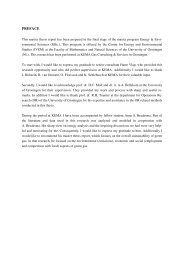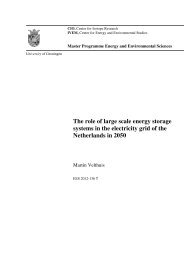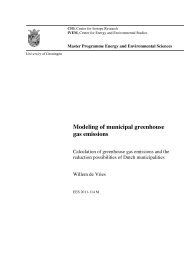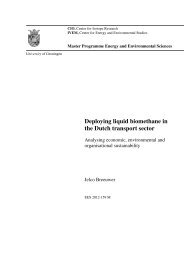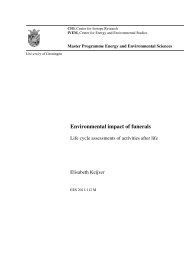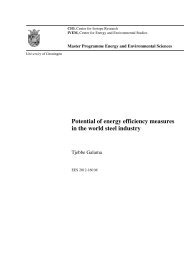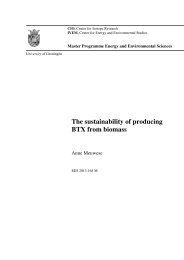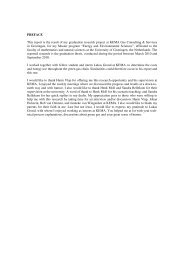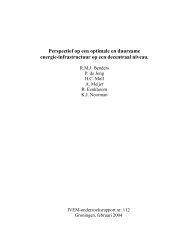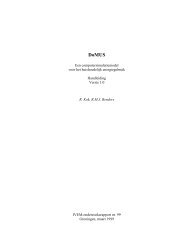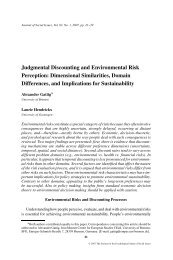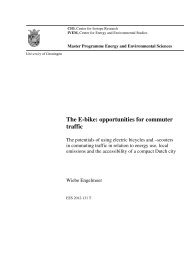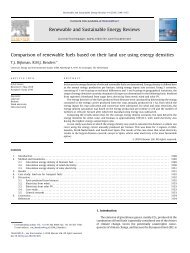Broadband dye-sensitized upconversion of near-infrared light
Broadband dye-sensitized upconversion of near-infrared light
Broadband dye-sensitized upconversion of near-infrared light
You also want an ePaper? Increase the reach of your titles
YUMPU automatically turns print PDFs into web optimized ePapers that Google loves.
ARTICLES<br />
PUBLISHED ONLINE: 15 JULY 2012 | DOI: 10.1038/NPHOTON.2012.158<br />
<strong>Broadband</strong> <strong>dye</strong>-<strong>sensitized</strong> <strong>upconversion</strong> <strong>of</strong><br />
<strong>near</strong>-<strong>infrared</strong> <strong>light</strong><br />
Wenqiang Zou 1 ,CindyVisser 1 ,JeremioA.Maduro 1 , Maxim S. Pshenichnikov 2<br />
and Jan C. Hummelen 1,2 *<br />
Photon <strong>upconversion</strong> <strong>of</strong> <strong>near</strong>-<strong>infrared</strong> photons is a promising way to overcome the Shockley–Queisser efficiency limit <strong>of</strong><br />
32% <strong>of</strong> a single-junction solar cell. However, the practical applicability <strong>of</strong> the most efficient known <strong>upconversion</strong> materials<br />
at moderate <strong>light</strong> intensities is limited by their extremely weak and narrowband <strong>near</strong>-<strong>infrared</strong> absorption. Here, we<br />
introduce the concept <strong>of</strong> an <strong>upconversion</strong> material where an organic <strong>near</strong>-<strong>infrared</strong> <strong>dye</strong> is used as an antenna for the<br />
b-NaYF 4:Yb,Er nanoparticles in which the <strong>upconversion</strong> occurs. The overall <strong>upconversion</strong> by the <strong>dye</strong>-<strong>sensitized</strong><br />
nanoparticles is dramatically enhanced (by a factor <strong>of</strong> ∼3,300) as a result <strong>of</strong> increased absorptivity and overall<br />
broadening <strong>of</strong> the absorption spectrum <strong>of</strong> the upconverter. The proposed concept can be extended to cover any part <strong>of</strong> the<br />
solar spectrum by using a set <strong>of</strong> <strong>dye</strong> molecules with overlapping absorption spectra acting as an extremely broadband<br />
antenna system, connected to suitable upconverters.<br />
One <strong>of</strong> the fundamental factors limiting the energy conversion<br />
efficiency <strong>of</strong> a single-junction solar cell to the Shockley–<br />
Queisser limit <strong>of</strong> ≏32% is the inability to absorb photons<br />
with energy less than the bandgap <strong>of</strong> the active materials 1 .<br />
Upconversion materials, which can sum the energies <strong>of</strong> <strong>near</strong>-<strong>infrared</strong><br />
(NIR) quanta to emit a quantum <strong>of</strong> higher energy, are considered<br />
to be one <strong>of</strong> the promising routes to overcoming this<br />
limit 2–6 . Other methods focus on adapting the absorption <strong>of</strong> the<br />
solar cell active-layer materials to the solar spectrum, but <strong>upconversion</strong><br />
modifies the solar spectrum to make it match better with the<br />
absorption spectrum <strong>of</strong> the solar cells. This strategy also makes it<br />
possible to electrically isolate the upconverters from the active<br />
layer and apply them as a separate layer in solar cells.<br />
In theory, the standard AM1.5 spectrum power conversion efficiency<br />
<strong>of</strong> a single-bandgap solar cell can be increased by up to 50.7%<br />
by the application <strong>of</strong> an ideal upconverter (with the two upconverter<br />
bandgaps at 0.94 and 1.40 eV), in combination with a photovoltaic<br />
active-layer material with a relatively wide bandgap <strong>of</strong> 2 eV<br />
(ref. 7). However, to date, the <strong>upconversion</strong> solar cell efficiencies<br />
obtained experimentally have been extremely low and merely<br />
serve as pro<strong>of</strong> <strong>of</strong> principle 3,8–12 . The main problem is that the<br />
known internally efficient <strong>upconversion</strong> materials absorb extremely<br />
weakly and within a very narrow spectral window. Moreover,<br />
<strong>upconversion</strong> is a process that is <strong>of</strong> higher order in <strong>light</strong> intensity<br />
(that is, quadratic in intensity for two-photon <strong>upconversion</strong> in the<br />
low-intensity limit), making very high illumination intensities<br />
<strong>of</strong>ten necessary. The best <strong>upconversion</strong> materials are currently<br />
based on mixed lanthanide compounds 11,13 . Promising <strong>upconversion</strong><br />
efficiencies have also been reported using (supra)molecular<br />
triplet–triplet annihilation systems 14–16 , but the spectral range <strong>of</strong><br />
650–700 nm to be upconverted is <strong>of</strong> limited relevance for solar<br />
cell applications. Of these materials, bulk NaYF 4:Er 3þ ,Yb 3þ and<br />
NaYF 4:Er 3þ have shown the highest <strong>upconversion</strong> quantum yields<br />
under monochromatic irradiation at 975 nm and 1,522 nm NIR<br />
<strong>light</strong> (5% and 3%, respectively 11,17 ). The corresponding<br />
NaYF 4:Er 3þ (2%),Yb 3þ (20%) nanoparticles typically show lower,<br />
size-dependent quantum yields; for example, 0.1% has been<br />
reported for 30-nm-diameter particles 17 . The inherently weak and<br />
narrowband absorption <strong>of</strong> Ln 3þ ions in such materials is due to<br />
the parity-forbidden nature <strong>of</strong> the 4f transitions. Hence, most <strong>of</strong><br />
the efforts to enhance Ln 3þ <strong>upconversion</strong> luminescence have<br />
focused on materials providing a locally enhanced electromagnetic<br />
field or on doping with other lanthanide ions, serving as sensitizers<br />
18–20 . For instance, plasmonic coupling was introduced to<br />
enhance the <strong>upconversion</strong> efficiency <strong>of</strong> lanthanide nanoparticles<br />
21–27 , resulting in enhancement factors <strong>of</strong> 2 to 8 (refs 21–23).<br />
More recently, the <strong>upconversion</strong> luminescence <strong>of</strong> gold-decorated<br />
b-NaYF 4:Yb,Tm nanoparticles at 345 nm was reported to be<br />
increased by a factor <strong>of</strong> 109 (ref. 27).<br />
Here, we propose and demonstrate the viability <strong>of</strong> a new strategy<br />
to enhance the <strong>upconversion</strong> luminescence <strong>of</strong> lanthanide nanoparticles<br />
based on increased and spectrally broadened absorption,<br />
using organic <strong>infrared</strong> <strong>dye</strong>s as sensitizers. The main idea was<br />
inspired by the natural <strong>light</strong>-harvesting systems in which various<br />
absorber molecules surround and transfer the solar energy to the<br />
central reaction centre 28 , albeit for <strong>upconversion</strong> instead <strong>of</strong> charge<br />
transfer. In our approach, <strong>dye</strong> molecules function as antennas,<br />
absorbing incident <strong>light</strong> and transferring their excitation energy to<br />
the upconverting metal ions encapsulated in a nanoparticle<br />
(Fig. 1). In a solar cell, the upconverted photon energy is then transferred<br />
radiatively or non-radiatively to the active layer. The advantages<br />
<strong>of</strong> combining organic antennas with inorganic <strong>upconversion</strong><br />
centres are (i) the strong NIR absorption, (ii) the broad absorption<br />
spectrum, (iii) the ability to tune the absorption band by molecular<br />
bandgap engineering, and (iv) the possibility <strong>of</strong> using a set <strong>of</strong> complementary<br />
antenna molecules to further optimize the absorption<br />
range (for example, in an energy cascade manner).<br />
We chose to show the first pro<strong>of</strong> <strong>of</strong> principle <strong>of</strong> <strong>dye</strong> sensitization<br />
using nanoparticle upconverters for 975 nm <strong>light</strong>, for chemical and<br />
instrumental reasons. Oleylamine-coated b-NaYF 4:Yb,Er nanoparticles<br />
with an average core diameter <strong>of</strong> 16 nm were prepared using a<br />
known method from a mixture <strong>of</strong> trifluoroacetates in oleylamine 29 .<br />
Solutions <strong>of</strong> these nanoparticles in CHCl 3 showed the characteristic<br />
bright green-yellow <strong>upconversion</strong> emission following excitation<br />
1 Stratingh Institute for Chemistry, University <strong>of</strong> Groningen, Nijenborgh 4, 9747 AG Groningen, The Netherlands, 2 Zernike Institute for Advanced Materials,<br />
University <strong>of</strong> Groningen, Nijenborgh 4, 9747 AG Groningen, The Netherlands. *e-mail: j.c.hummelen@rug.nl<br />
560<br />
© 2012 Macmillan Publishers Limited. All rights reserved.<br />
NATURE PHOTONICS | VOL 6 | AUGUST 2012 | www.nature.com/naturephotonics
NATURE PHOTONICS DOI: 10.1038/NPHOTON.2012.158 ARTICLES<br />
NIR<br />
NIR<br />
Antenna<br />
FRET<br />
with ≏975 nm laser <strong>light</strong>. A commercially available cyanine <strong>dye</strong>,<br />
IR-780, was selected as the starting material for the preparation <strong>of</strong><br />
functionalized antenna molecules to be attached to the surface <strong>of</strong><br />
the nanoparticles. Nucleophilic substitution <strong>of</strong> the central chlorine<br />
atom in IR-780 was used as the method to prepare a carboxylic<br />
acid-functionalized derivative (see Supplementary Sections A–C<br />
for details). The resulting carboxylated <strong>dye</strong> absorbs <strong>light</strong> mainly<br />
between 650 and 850 nm, with a maximum at 806 nm in CHCl 3<br />
(Fig. 2a); we therefore named it IR-806. The extinction coefficient<br />
<strong>of</strong> IR-806 at 806 nm is 390 l g 21 cm 21 , which is ≏5 × 10 6 times<br />
higher than that <strong>of</strong> b-NaYF 4:Yb,Er nanoparticles at 975 nm<br />
(7 × 10 25 lg 21 cm 21 ). Weak absorption <strong>of</strong> IR-806 below 600 nm<br />
is also essential, because the antenna <strong>dye</strong> should be transparent<br />
for the upconverted photons that exit the nanoparticle.<br />
At 750 nm excitation, the emission spectrum <strong>of</strong> IR-806 in<br />
CHCl 3 extends well beyond 900 nm (Fig. 2b). The overlap<br />
between the emission spectrum <strong>of</strong> IR-806 and the absorption<br />
spectrum <strong>of</strong> the nanoparticles at 900–1,000 nm, albeit not<br />
optimal, still allows for Förster-type energy transfer from<br />
excited IR-806 to the Yb 3þ absorption centres in the nanoparticles.<br />
The exchange reaction with the oleylamine ligands and<br />
binding <strong>of</strong> IR-806 to the surface <strong>of</strong> the nanoparticle were determined<br />
by clearly observable changes <strong>of</strong> absorption in the NIR<br />
and <strong>infrared</strong> regions as well as in the emission properties<br />
(Supplementary Figs S6–S8). First, following the addition <strong>of</strong> oleylamine-coated<br />
nanoparticles to a solution <strong>of</strong> IR-806 in CHCl 3,the<br />
absorption <strong>of</strong> IR-806 at 806 nm decreased and the absorption<br />
maximum wavelength gradually blueshifted from 806 nm to a saturation<br />
value <strong>of</strong> 800 nm (Supplementary Fig. S7a). Second, the<br />
IR-806 luminescence decreased to 35% <strong>of</strong> the original intensity<br />
(Supplementary Fig. S8a). In a blank experiment in which<br />
IR-806 was bound to oleylamine-coated NaYF 4 nanoparticles<br />
with no Yb and Er photon energy acceptors, an identical blueshift<br />
in IR-806 absorption was observed (Supplementary Fig. S7b), but<br />
the luminescence decrease was only to 90% <strong>of</strong> the original intensity<br />
(Supplementary Fig. S8b). Third, the lifetime <strong>of</strong> IR-806<br />
luminescence shortened from 1.14 ns (pure IR-806) to 0.64 ns<br />
(IR-806:nanoparticle) upon binding to the NaYF 4:Yb,Er nanoparticles<br />
(Supplementary Fig. S9). This set <strong>of</strong> experiments<br />
FRET<br />
Upconverter<br />
Figure 1 | Principal concept <strong>of</strong> the <strong>dye</strong>-<strong>sensitized</strong> nanoparticle. Antenna<br />
<strong>dye</strong>s (green) absorb NIR solar energy (red wavy arrows) and transfer it<br />
(brown arrows) to the nanoparticle core (in yellow), where <strong>upconversion</strong><br />
occurs. Upconversion denotes a nonli<strong>near</strong> (on the incident radiation<br />
intensity) process in which the energies <strong>of</strong> two NIR quanta are summed to<br />
emit a quantum <strong>of</strong> higher energy in the green-yellow region (green-yellow<br />
wavy arrow).<br />
VIS<br />
a<br />
OD (a.u.)<br />
b<br />
Photoluminescence intensity (a.u.)<br />
1.0<br />
0.8<br />
0.6<br />
0.4<br />
0.2<br />
0.0<br />
400 500 600 700 800 900 1,000<br />
Wavelength (nm)<br />
1.5<br />
1.0<br />
0.5<br />
0.0<br />
IR-780<br />
IR-806<br />
Photoluminescence <strong>of</strong> IR-806<br />
Absorbance <strong>of</strong> nanoparticles<br />
800 850 900 950<br />
Wavelength (nm)<br />
0.06<br />
0.04<br />
0.02<br />
0.00<br />
Figure 2 | Absorption and emission spectra. a, Absorption spectra <strong>of</strong><br />
IR-780 (3.0 × 10 26 M; blue line) and carboxylic acid derivative IR-806<br />
(3.18 × 10 26 M; red line) in CHCl 3 . b, Emission spectrum <strong>of</strong> IR-806 in CHCl 3<br />
(3.18 × 10 26 M; red line) and absorption spectrum <strong>of</strong> oleylamine-coated<br />
b-NaYF 4:Yb,Er in CHCl 3 (green line). OD, optical density.<br />
demonstrates that ≏50% <strong>of</strong> the photon energy initially absorbed<br />
by bound IR-806 is transferred to the Yb and Er energy-accepting<br />
ions in the NaYF 4:Yb,Er nanoparticle core.<br />
This conclusion was also verified by similar measurements on the<br />
original IR-780 (which cannot bind to the nanoparticles) instead <strong>of</strong><br />
IR-806; no changes in IR-780 absorption and emission were<br />
observed (Supplementary Figs S10,S11). Finally, the Fourier transform<br />
<strong>infrared</strong> (FTIR) spectrum <strong>of</strong> a sample <strong>of</strong> dried and washed<br />
<strong>dye</strong>-coated nanoparticles resembles a superposition <strong>of</strong> the two<br />
spectra <strong>of</strong> oleylamine-coated nanoparticles and the <strong>dye</strong><br />
(Supplementary Fig. S6). This strongly suggests that close proximity<br />
<strong>of</strong> the <strong>dye</strong> (secured by chemisorption in the case <strong>of</strong> IR-806) and<br />
nanoparticle is necessary for efficient energy transfer.<br />
The <strong>upconversion</strong> spectrum <strong>of</strong> the solution containing IR-806functionalized<br />
nanoparticles under 800 nm, 2 mW continuouswave<br />
(c.w.) laser excitation is shown in Fig. 3a. There are<br />
threecharacteristicEr 3þ emission bands at 510–530 nm, 530–570 nm<br />
and 630–680 nm, corresponding to 2 H 11/2 4 I 15/2, 4 S 3/2 4 I 15/2<br />
and 4 F 9/2 4 I 15/2 transitions, respectively 27 . The 500–700 nm<br />
spectral distribution <strong>of</strong> upconverted <strong>light</strong> from the IR-806/nanoparticles<br />
samples irradiated at 800 nm (2 mW) was determined to<br />
be similar to that <strong>of</strong> samples <strong>of</strong> pure nanoparticles irradiated at<br />
975 nm (50 mW) (Supplementary Fig. S12). This clearly indicates<br />
that the 800 nm photon energy is absorbed by IR-806, transferred<br />
to the nanoparticle core, upconverted to a higher photon energy,<br />
and subsequently re-emitted. In the cases <strong>of</strong> solutions <strong>of</strong> pure<br />
oleylamine-capped nanoparticles, pure IR-806 in CHCl 3 (800 nm<br />
NATURE PHOTONICS | VOL 6 | AUGUST 2012 | www.nature.com/naturephotonics 561<br />
© 2012 Macmillan Publishers Limited. All rights reserved.<br />
OD
ARTICLES<br />
a<br />
Photoluminescence intensity (a.u.)<br />
b<br />
Photoluminescence intensity (a.u.)<br />
0.6<br />
0.4<br />
0.2<br />
0.0<br />
450 500 550 600 650<br />
Wavelength (nm)<br />
2.0<br />
1.5<br />
1.0<br />
0.5<br />
0.0<br />
0.000 0.005 0.010<br />
IR-806 (mg ml−1 )<br />
Nanoparticles<br />
IR-806<br />
IR-780/nanoparticles<br />
IR-806/nanoparticles<br />
0.015 0.020<br />
Figure 3 | Upconversion emission intensities. a, Steady-state emission<br />
spectra <strong>of</strong> b-NaYF 4:Yb,Er nanoparticles (cyan line, no spectrum produced),<br />
IR-806 (green line, no spectrum produced), b-NaYF 4:Yb,Er nanoparticles/IR-<br />
780 (0.80/0.006 mg ml 21 ; red line) and b-NaYF 4 :Yb,Er nanoparticles/IR-<br />
806 (0.80/0.006 mg ml 21 ; blue line) in CHCl 3 excited by a 2 mW, 800 nm<br />
c.w. laser. b, Emission intensity integrated in the range 500–685 nm <strong>of</strong><br />
b-NaYF 4:Yb,Er nanoparticles (0.80 mg ml 21 ) as a function <strong>of</strong> IR-806<br />
content (in CHCl 3) excited by a 2 mW, 800 nm c.w. laser.<br />
excitation) and mixtures <strong>of</strong> non-functionalized IR-780 and<br />
nanoparticles (780 nm excitation), no detectable <strong>upconversion</strong><br />
emission was observed, in full agreement with the absorption<br />
and fluorescent quenching experiments. Therefore, we conclude<br />
that functionalized IR-806 (secured by chemisorption) acts as an<br />
antenna for the b-NaYF 4:Yb,Er nanoparticles for the<br />
<strong>upconversion</strong> process.<br />
We next determined the optimal surface coverage <strong>of</strong> the nanoparticles<br />
by antenna molecules so as to achieve the most efficient<br />
<strong>dye</strong>-<strong>sensitized</strong> <strong>upconversion</strong> (Fig. 3b). On adding IR-806 to a solution<br />
<strong>of</strong> nanoparticles, the <strong>upconversion</strong> emission intensity first<br />
increases, which is consistent with an increasing overall absorption<br />
<strong>of</strong> the excitation energy at 800 nm by an increasing number <strong>of</strong><br />
surface-bound antenna molecules. However, beyond a certain concentration,<br />
the further increase in the IR-806/nanoparticle ratio<br />
results in a decreasing <strong>upconversion</strong> emission intensity. The<br />
observed decline can be explained by two factors: increased<br />
mutual interactions between antenna molecules on the nanoparticle<br />
surface (self-quenching) and an increasing concentration <strong>of</strong><br />
unbound (excess) antenna molecules, which absorb the excitation<br />
energy but do not transfer it to the nanoparticles. The optimum<br />
IR-806:nanoparticle weight ratio was determined as 1:133. We estimate<br />
that a mean <strong>of</strong> 70+20 antenna molecules per average sized<br />
nanoparticle are bound at this ratio, with a centre-to-centre<br />
562<br />
700<br />
NATURE PHOTONICS DOI: 10.1038/NPHOTON.2012.158<br />
intermolecular distance <strong>of</strong> ≏3.4 nm (Supplementary Section E).<br />
This optimal concentration was used in all subsequent experiments.<br />
Figure 4 shows the <strong>upconversion</strong> emission intensity integrated in<br />
the range 500–685 nm as a function <strong>of</strong> incident power. The best fit<br />
with a power function results in a perfect quadratic dependence on<br />
the incident <strong>light</strong> intensity. This confirms that the mechanism <strong>of</strong> the<br />
antenna-mediated process involves a two-photon <strong>upconversion</strong><br />
step. Based on this set <strong>of</strong> observations we propose the following<br />
mechanism for the overall process in the IR-806/nanoparticles solution,<br />
and call it ‘<strong>dye</strong>-<strong>sensitized</strong> <strong>upconversion</strong>’ (DUC). In this<br />
mechanism, the bound IR-806 antenna molecules absorb the NIR<br />
photons and transfer their excitation energy to the Yb 3þ 2 F5/2 level by resonance energy transfer. The typical energy transfer processes<br />
from Yb 3þ to Er 3þ follow13 , eventually leading to the Er 3þ<br />
emission <strong>of</strong> upconverted <strong>light</strong>.<br />
The monochromatic quantum yield (mQY) <strong>of</strong> the IR-806/nanoparticles<br />
was determined at an excitation wavelength <strong>of</strong> 800 nm as<br />
þ0.10<br />
0.1220.05% at the intensity saturation point (Fig. 4) for monochromatic<br />
illumination (for details see Supplementary Section F). The<br />
mQY <strong>of</strong> our non-<strong>sensitized</strong> oleylamine-coated nanoparticles was<br />
measured to be 0.3+0.1% at the maximum absorption wavelength<br />
<strong>of</strong> 975 nm. This value is in good agreement with the reported mQY<br />
value17 <strong>of</strong> 0.1% for s<strong>light</strong>ly larger (30 nm diameter) but otherwise<br />
similar oleylamine-coated nanoparticles given the higher intensities<br />
used here. The two mQYs are, within experimental error, in reasonable<br />
agreement with the observed luminescence quenching and<br />
excited-state lifetime shortening <strong>of</strong> the nanoparticle-bound <strong>dye</strong><br />
described above.<br />
The <strong>upconversion</strong> action spectrum (that is, upconverted power<br />
as a function <strong>of</strong> excitation wavelength) was recorded using a<br />
2 mW calibrated wavelength-tunable c.w. laser. It was first confirmed<br />
that the emission spectrum <strong>of</strong> the sample was independent<br />
<strong>of</strong> the excitation wavelength in the 720–1,000 nm spectral range.<br />
The integrated power over the 500–685 nm range <strong>of</strong> the emission<br />
was then plotted versus excitation wavelength (Fig. 5). The <strong>upconversion</strong><br />
action peak in the range 740–850 nm corresponds to the<br />
squared absorption <strong>of</strong> IR-806, and the tiny action peak in<br />
the 900–990 nm range follows the squared absorption <strong>of</strong><br />
b-NaYF4:Yb,Er (Fig. 5, inset). This is fully consistent with the<br />
proposed DUC mechanism comprising a two-photon process in<br />
which the antenna molecules are involved as initial absorbers.<br />
The dramatic effect <strong>of</strong> the <strong>dye</strong>-<strong>sensitized</strong> process is immediately<br />
evident from the main panel, where the contribution from<br />
Photoluminescence intensity (a.u.)<br />
10 5<br />
10 4<br />
10 3<br />
10 2<br />
10 1<br />
10 0<br />
Experimental data<br />
Best fit with y = a*x n n = 1.92<br />
0.1 1 10<br />
Excitation power (mW)<br />
Figure 4 | Upconversion photoluminescence intensity as a function <strong>of</strong><br />
excitation power. Integrated in the range 500–685 nm, <strong>upconversion</strong><br />
intensity <strong>of</strong> b-NaYF 4:Yb,Er nanoparticles/IR-806 (0.80/0.006 mg ml 21 )in<br />
CHCl 3 as a function <strong>of</strong> excitation power from an 800 nm c.w. laser. A best<br />
fit with a power function yields the exponent factor n ¼ 1.92, indicating a<br />
purely two-photon process.<br />
© 2012 Macmillan Publishers Limited. All rights reserved.<br />
NATURE PHOTONICS | VOL 6 | AUGUST 2012 | www.nature.com/naturephotonics
NATURE PHOTONICS DOI: 10.1038/NPHOTON.2012.158 ARTICLES<br />
Photoluminescence intensity (a.u.)<br />
6<br />
4<br />
2<br />
0<br />
750<br />
Nanoparticles/IR-806<br />
Nanoparticles<br />
× 1,000<br />
940 960<br />
800 850 900 950<br />
Excitation wavelength (nm)<br />
Figure 5 | Upconversion action spectra. Experimental <strong>upconversion</strong><br />
excitation spectra <strong>of</strong> b-NaYF 4:Yb,Er nanoparticles/IR-806<br />
(0.80/0.006 mg ml 21 ;bluecircles)andb-NaYF 4:Yb,Er nanoparticles<br />
(0.80 mg ml 21 ; green triangles), both dissolved in CHCl 3 . The emission<br />
intensity is integrated in the 500–685 nm range with excitation from a<br />
2 mW c.w. laser. The red line shows the squared absorption spectrum. Inset:<br />
wavelength range from 940 to 1,000 nm, magnified by a factor <strong>of</strong> 1,000.<br />
<strong>upconversion</strong> by the non-<strong>sensitized</strong> process around 975 nm is<br />
simply invisible on this scale. However, as the inset shows, the<br />
non-<strong>sensitized</strong> <strong>upconversion</strong> does take place in this range.<br />
Importantly, this process has a similar efficiency and spectral<br />
response for non-coated and <strong>dye</strong>-coated nanoparticles, which<br />
proves that the <strong>upconversion</strong> properties <strong>of</strong> the nanoparticles were<br />
not compromised following <strong>dye</strong> attachment. Although the peak-topeak<br />
(at 975 nm versus at 800 nm) ratio <strong>of</strong> non-<strong>sensitized</strong> and <strong>sensitized</strong><br />
<strong>upconversion</strong> is ≏1:1,100, the integrated spectral response in the<br />
720–1,000 nm range from the <strong>dye</strong>-coated nanoparticles, as shown in<br />
Fig. 5, is ≏3,300 times stronger than that <strong>of</strong> the non-<strong>sensitized</strong><br />
nanoparticles. This result lends further support for the DUC mechanism<br />
operating in the excitation range where IR-806 absorbs, and<br />
‘direct’ <strong>upconversion</strong> by the nanoparticles operating in the range<br />
where the nanoparticles absorb.<br />
In conclusion, we have demonstrated that <strong>dye</strong>-<strong>sensitized</strong> <strong>upconversion</strong><br />
<strong>of</strong> nanoparticles yields a dramatically increased <strong>upconversion</strong><br />
efficiency. Further improvement can be obtained by<br />
optimization <strong>of</strong> the <strong>dye</strong> emission and nanoparticle absorption spectral<br />
overlap. Moreover, we propose that by using suitable co-sensitizing<br />
sets <strong>of</strong> antenna molecules and upconverting nanoparticles,<br />
together absorbing the full desired spectral range <strong>of</strong> <strong>light</strong> to be<br />
upconverted, it will be possible to obtain even greater broadband<br />
<strong>upconversion</strong>. Such broadband sensitization, in combination with<br />
higher quantum yield upconverters, would change <strong>upconversion</strong><br />
from an academic and exotic phenomenon into a realistic and<br />
viable tool for increasing the efficiency <strong>of</strong> photovoltaic devices.<br />
Furthermore, as the absorption spectrum <strong>of</strong> the <strong>dye</strong>-<strong>sensitized</strong><br />
upconverter can be tuned, analyses and imaging techniques in<br />
medicine and diagnostics 13 based on upconverting nanoparticles<br />
will also benefit greatly from the proposed approach.<br />
Methods<br />
Synthesis <strong>of</strong> IR-806. The functionalization reaction was performed using standard<br />
Schlenk-line techniques in dry glassware and under a dry nitrogen atmosphere.<br />
A mixture <strong>of</strong> IR-780 iodide (2-[2-[2-chloro-3-[(1,3-dihydro-3,3-dimethyl-1-propyl-<br />
2H-indol-2-ylidene)ethylidene]-1-cyclohexen-1-yl]ethenyl]-3,3-dimethyl-1propylindolium<br />
iodide; 500 mg, 0.75 mmol) and 4-mercaptobenzoic acid (231 mg,<br />
1.50 mmol) in dimethylformamide (DMF) (20 ml) was stirred at room temperature<br />
for 17 h. DMF was removed under vacuum at 40 8C, and the residue was dissolved in<br />
CH 2Cl 2 (5 ml). The solution was filtered through a 0.45 mm polytetrafluoroethylene<br />
syringe filter and diethyl ether (150 ml) was added slowly to precipitate the product.<br />
The precipitate was collected by centrifugation, washed with diethyl ether, and dried<br />
under vacuum to afford 506 mg (0.65 mmol, 86%) <strong>of</strong> gold-coloured crystals. For<br />
characterization data see Supplementary Information.<br />
980<br />
Synthesis <strong>of</strong> NaYF 4:Yb,Er and NaYF 4 nanoparticles. NaYF 4:Yb,Er nanoparticles<br />
were synthesized according to a method described in the literature 29 . The reaction<br />
was performed using standard Schlenk-line techniques in dry glassware under a dry<br />
N 2 atmosphere. CF 3COONa (544 mg, 4 mmol), Y(CF 3COO) 3 .3H 2O (752 mg,<br />
1.56 mmol), Yb(CF 3 COO) 3 .3H 2 O (226 mg, 0.40 mmol), Er(CF 3 COO) 3 .3H 2 O<br />
(23 mg, 0.04 mmol) and oleylamine (20 ml) were added to a 100 ml three-neck<br />
round-bottom flask. With vigorous stirring, the mixture was heated to 100 8C at<br />
reduced pressure for 0.5 h to remove water and oxygen; heating was then continued<br />
up to 340 8C in the presence <strong>of</strong> nitrogen. After 1 h at 340 8C, heating was stopped.<br />
When the reaction temperature reached 80 8C, ethanol (150 ml) was added.<br />
The nanoparticles were isolated by centrifugation. The as-precipitated nanoparticles<br />
were washed three times with ethanol and then dispersed in 5 ml <strong>of</strong> chlor<strong>of</strong>orm.<br />
Undoped NaYF 4 nanoparticles were synthesized similarly, without the addition <strong>of</strong><br />
the Yb and Er salts.<br />
Sample preparation for UV-vis-NIR absorption and fluorescence measurements.<br />
All samples were prepared and measured under an atmosphere <strong>of</strong> nitrogen. The<br />
samples for UV-vis-NIR absorption and standard fluorescence measurements were<br />
prepared by adding different amounts <strong>of</strong> NaYF 4:Yb,Er nanoparticles to 0.01 mg <strong>of</strong><br />
IR-806 in CHCl 3 (4 ml) . The solutions were then stirred for 2 h at room temperature.<br />
The samples for <strong>upconversion</strong> fluorescence measurements were prepared by adding<br />
different amounts <strong>of</strong> IR-806 to 40 mg <strong>of</strong> NaYF 4:Yb,Er nanoparticles in CHCl 3<br />
(1 ml). The solutions were stirred for 2 h at room temperature, then diluted 50 times<br />
for measurement.<br />
Spectroscopy. For the <strong>upconversion</strong> luminescence measurements, a Ti:sapphire<br />
laser system (MIRA-900-F) was used as the excitation source. Luminescence spectra<br />
and lifetime measurements were performed in c.w. and pulsed modes (repetition<br />
rate <strong>of</strong> 76 MHz), respectively. The excitation <strong>light</strong> was focused into a 1-mm-thick<br />
sample cell by a lens with a focal length <strong>of</strong> 75 mm. This resulted in a focal spot <strong>of</strong><br />
35+10 mm (FWHM) level. The excitation power was controlled by a gradient<br />
neutral density filter and set at 2 mW for all experiments, with the exception <strong>of</strong> the<br />
power-dependence measurements. The emission was collected with a right-angled<br />
geometry by an f/2 collimating lens and subsequently focused by an f/4 lens onto<br />
the slit <strong>of</strong> the spectrograph. The (time-resolved) emission detection was performed<br />
using a streak camera system equipped with a spectrograph (Hamamatsu C5680)<br />
running with the vertical time axis sweep <strong>of</strong>f while recording c.w. emission spectra.<br />
Received 17 April 2012; accepted 9 June 2012;<br />
published online 15 July 2012<br />
References<br />
1. Shockley, W. & Queisser, H. J. Detailed balance limit <strong>of</strong> efficiency <strong>of</strong> p–n<br />
junction solar cells. J. Appl. Phys. 32, 510–519 (1961).<br />
2. Conibeer, G. Third-generation photovoltaics. Mater. Today 10, 42–50 (2007).<br />
3. Wang, H.-Q., Batentschuk, M., Osvet, A., Pinna, L. & Brabec, C. J. Rare-earth ion<br />
doped up- conversion materials for photovoltaic applications. Adv. Mater. 23,<br />
2675–2680 (2011).<br />
4. Van der Ende, B. M., Aarts, L. & Meijerink, A. Lanthanide ions as spectral<br />
converters for solar cells. Phys. Chem. Chem. Phys. 11, 11081–11095 (2009).<br />
5. De Wild, J., Meijerink, A., Rath, J. K., van Sark, W. G. J. H. M. & Schropp, R. E. I.<br />
Upconverter solar cells: materials and applications. Energy Environ. Sci. 4,<br />
4835–4848 (2011).<br />
6. Strümpel, C. et al. Modifying the solar spectrum to enhance silicon solar cell<br />
efficiency—an overview <strong>of</strong> available materials. Sol. Energy Mater. Sol. Cells 91,<br />
238–249 (2007).<br />
7. Trupke, T., Shalav, A., Richards, B. S., Würfel, P. & Green, M. A. Efficiency<br />
enhancement <strong>of</strong> solar cells by luminescent up-conversion <strong>of</strong> sun<strong>light</strong>. Sol. Energy<br />
Mater. Sol. Cells 90, 3327–3338 (2006).<br />
8. Shalav, A., Richards, B. S., Trupke, T., Kramer, K. W. & Gudel, H. U. Application<br />
<strong>of</strong> NaYF 4:Er 3þ up-converting phosphors for enhanced <strong>near</strong>-<strong>infrared</strong> silicon<br />
solar cell response. Appl. Phys. Lett. 86, 013505 (2005).<br />
9. Shan, G.-B. & Demopoulos, G. P. Near-<strong>infrared</strong> sun<strong>light</strong> harvesting in <strong>dye</strong><strong>sensitized</strong><br />
solar cells via the insertion <strong>of</strong> an upconverter-TiO 2 nanocomposite<br />
layer. Adv. Mater. 22, 4373–4377 (2010).<br />
10. De Wild, J., Rath, J. K., Meijerink, A., van Sark, W. G. J. H. M. & Schropp, R. E. I.<br />
Enhanced <strong>near</strong>-<strong>infrared</strong> response <strong>of</strong> a-Si:H solar cells with b-NaYF 4:Yb 3þ<br />
(18%), Er 3þ (2%) <strong>upconversion</strong> phosphors. Sol. Energy Mater. Sol. Cells 94,<br />
2395–2398 (2010).<br />
11. Fischer, S. et al. Enhancement <strong>of</strong> silicon solar cell efficiency by <strong>upconversion</strong>:<br />
optical and electrical characterization. J. Appl. Phys. 108, 044912 (2010).<br />
12. Shalav, A., Richards, B. S. & Green, M. A. Luminescent layers for enhanced<br />
silicon solar cell performance: up-conversion. Sol. Energy Mater. Sol. Cells 91,<br />
829–842 (2007).<br />
13. Haase, M. & Schäfer, H. Upconverting nanoparticles. Angew. Chem. Int. Ed. 50,<br />
5808–5829 (2011).<br />
14. Baluschev, S. et al. Up-conversion fluorescence: noncoherent excitation by<br />
sun<strong>light</strong>. Phys. Rev. Lett. 97, 143903–06 (2006).<br />
NATURE PHOTONICS | VOL 6 | AUGUST 2012 | www.nature.com/naturephotonics 563<br />
© 2012 Macmillan Publishers Limited. All rights reserved.
ARTICLES<br />
15. Baluschev, S. et al. A general approach for non-coherently excited annihilation<br />
up-conversion: transforming the solar-spectrum. New J. Phys. 10,<br />
013007 (2008).<br />
16. Cheng, Y. Y. et al. Improving the <strong>light</strong>-harvesting <strong>of</strong> amorphous silicon solar<br />
cells with photochemical <strong>upconversion</strong>. Energy Environ. Sci. 5,<br />
6953–6959 (2012).<br />
17. Boyer, J.-Ch. & van Veggel, F. C. J. M. Absolute quantum yield measurements <strong>of</strong><br />
colloidal NaYF4: Er 3þ ,Yb 3þ upconverting nanoparticles, Nanoscale 2,<br />
1417–1419 (2010).<br />
18. Auzel, F. Upconversion and anti-Stokes processes with f and d ions in solids.<br />
Chem. Rev. 104, 139–173 (2004).<br />
19. Wang, F. & Liu, X. Recent advances in the chemistry <strong>of</strong> lanthanide-doped<br />
<strong>upconversion</strong> nanocrystals. Chem. Soc. Rev. 38, 976–989 (2009).<br />
20. Gamelin, D. R. & Güdel, H. U. Design <strong>of</strong> luminescent inorganic materials: new<br />
photophysical processes studied by optical spectroscopy. Acc. Chem. Res. 33,<br />
235–242 (2000).<br />
21. Verhagen E., Kuipers, L. & Polman A. Enhanced nonli<strong>near</strong> optical effects with a<br />
tapered plasmonic waveguide. Nano Lett. 7, 334–337 (2007).<br />
22. Rai, V. K. et al. Frequency <strong>upconversion</strong> in a Pr 3þ doped chalcogenide glass<br />
containing silver nanoparticles. J. Appl. Phys. 103, 093526 (2008).<br />
23. Kassab, L. R. P. et al. Energy transfer and frequency <strong>upconversion</strong> in Yb 3þ –Er 3þ -<br />
doped PbO–GeO 2 glass containing silver nanoparticles. Appl. Phys. B 94,<br />
239–242 (2009).<br />
24. Schietinger, S., Aichele, T., Wang, H., Nann, T. & Benson, O. Plasmon-enhanced<br />
<strong>upconversion</strong> in single NaYF 4:Yb 3þ /Er 3þ codoped nanocrystals. Nano Lett. 10,<br />
134–138 (2010).<br />
25. Zhang, H. et al. Plasmonic modulation <strong>of</strong> the <strong>upconversion</strong> fluorescence in<br />
NaYF 4 :Yb/Tm hexaplate nanocrystals using gold nanoparticles or nanoshells.<br />
Angew. Chem. Int. Ed. 49, 2865–2868 (2010).<br />
564<br />
NATURE PHOTONICS DOI: 10.1038/NPHOTON.2012.158<br />
26. Sudheendra, L., Ortalan, V., Dey, S., Browning, N. D. & Kennedy, I. M.<br />
Plasmonic enhanced emissions from cubic NaYF 4:Yb:Er/Tm nanophosphors.<br />
Chem. Mater. 23, 2987–2993 (2011).<br />
27. Liu, N., Qin, W., Qin, G., Jiang, T. & Zhao, D. Highly plasmon-enhanced<br />
<strong>upconversion</strong> emissions from Au@b-NaYF 4 :Yb,Tm hybrid nanostructures.<br />
Chem. Commun. 47, 7671–7673 (2011)<br />
28. Blankenship, R. E. Molecular Mechanisms <strong>of</strong> Photosynthesis (Blackwell<br />
Science, 2002).<br />
29. Yi, G. S. & Chow, G. M. Synthesis <strong>of</strong> hexagonal-phase NaYF 4:Yb,Er and<br />
NaYF 4:Yb,Tm nanocrystals with efficient up-conversion fluorescence. Adv.<br />
Funct. Mater. 16, 2324–2329 (2006).<br />
Acknowledgements<br />
J.C.H., W.Z. and C.V. acknowledge financial support from the Joint Solar Programme<br />
(JSP 1) <strong>of</strong> the Stichting voor Fundamenteel Onderzoek der Materie (FOM). The authors<br />
thank M.C.A. Stuart for TEM measurements <strong>of</strong> the nanoparticles and H.M.M. Hesp for<br />
assistance with laser spectroscopy. This is the first publication by the FOM Focus<br />
Group Groningen, participating in the Dutch Institute for Fundamental Energy<br />
Research (DIFFER).<br />
Author contributions<br />
W.Z., C.V. and J.A.M. were responsible for the experimental work. J.C.H. conceived the<br />
project. J.C.H. and M.S.P. supervised the research. All authors discussed the results.<br />
The manuscript was written by W.Z., M.S.P. and J.C.H.<br />
Additional information<br />
The authors declare no competing financial interests. Supplementary information<br />
accompanies this paper at www.nature.com/naturephotonics. Reprints and permission<br />
information is available online at http://www.nature.com/reprints. Correspondence and<br />
requests for materials should be addressed to J.C.H.<br />
© 2012 Macmillan Publishers Limited. All rights reserved.<br />
NATURE PHOTONICS | VOL 6 | AUGUST 2012 | www.nature.com/naturephotonics



